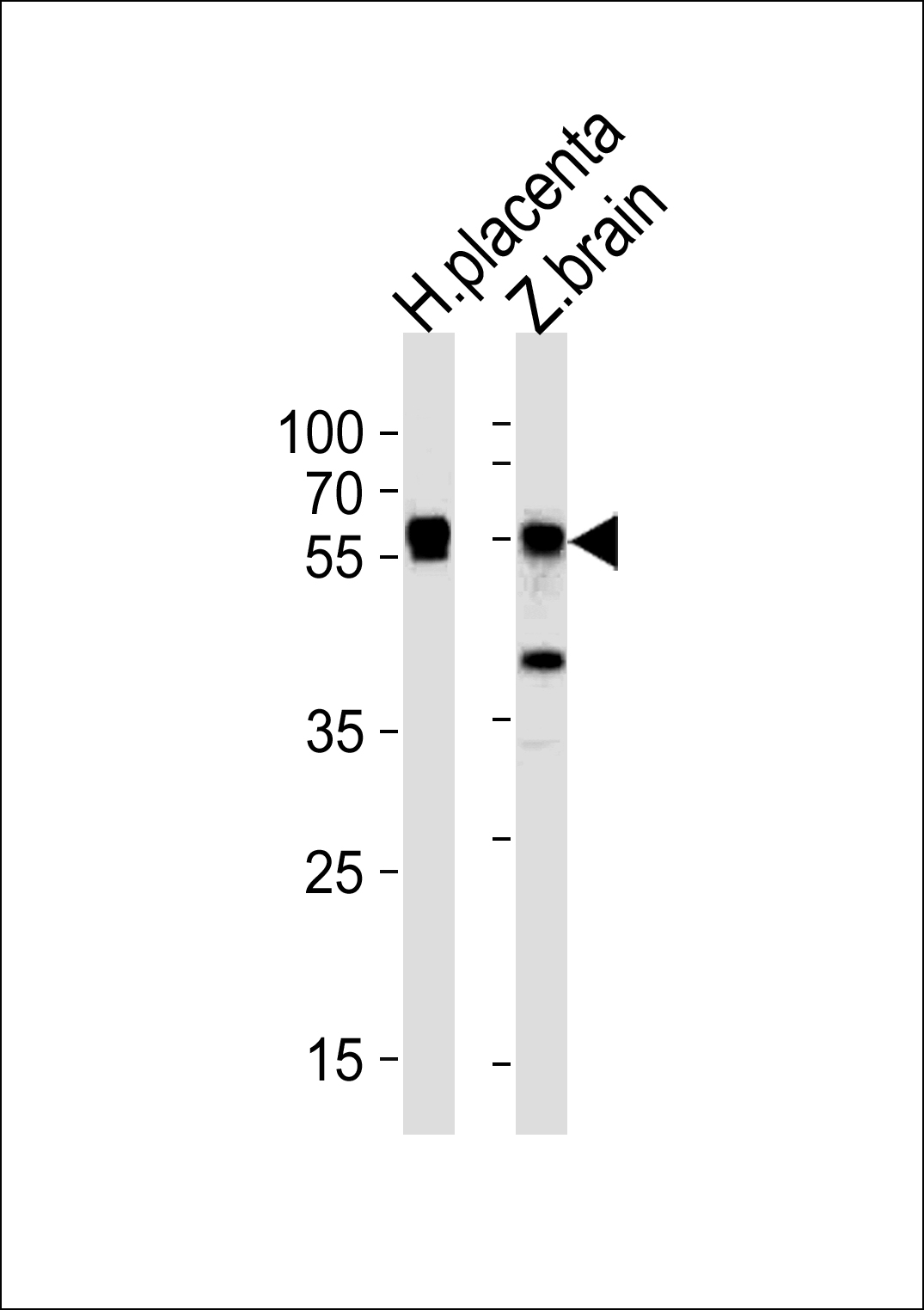DANRE stk3(36kDa subunit) Antibody (Center)
Purified Rabbit Polyclonal Antibody (Pab)
- SPECIFICATION
- CITATIONS
- PROTOCOLS
- BACKGROUND

Application
| WB, E |
|---|---|
| Primary Accession | Q7ZUQ3 |
| Reactivity | Human, Zebrafish |
| Host | Rabbit |
| Clonality | Polyclonal |
| Isotype | Rabbit IgG |
| Clone/Animal Names | RB47395 |
| Calculated MW | 56081 Da |
| Gene ID | 324125 |
|---|---|
| Other Names | Serine/threonine-protein kinase 3, Serine/threonine-protein kinase 3 36kDa subunit, MST2/N, Serine/threonine-protein kinase 3 20kDa subunit, MST2/C, stk3 |
| Target/Specificity | This DANRE stk3(36kDa subunit) antibody is generated from a rabbit immunized with a KLH conjugated synthetic peptide between 228-252 amino acids from the Central region of DANRE stk3(36kDa subunit). |
| Dilution | WB~~1:1000 |
| Format | Purified polyclonal antibody supplied in PBS with 0.09% (W/V) sodium azide. This antibody is purified through a protein A column, followed by peptide affinity purification. |
| Storage | Maintain refrigerated at 2-8°C for up to 2 weeks. For long term storage store at -20°C in small aliquots to prevent freeze-thaw cycles. |
| Precautions | DANRE stk3(36kDa subunit) Antibody (Center) is for research use only and not for use in diagnostic or therapeutic procedures. |
| Name | stk3 |
|---|---|
| Function | Stress-activated, pro-apoptotic kinase which, following caspase-cleavage, enters the nucleus and induces chromatin condensation followed by internucleosomal DNA fragmentation. Key component of the Hippo signaling pathway which plays a pivotal role in organ size control and tumor suppression by restricting proliferation and promoting apoptosis. The core of this pathway is composed of a kinase cascade wherein stk3/mst2 and stk4/mst1, in complex with its regulatory protein sav1, phosphorylates and activates lats1/2 in complex with its regulatory protein mob1, which in turn phosphorylates and inactivates yap1 oncoprotein and wwtr1/taz. Phosphorylation of yap1 by lats2 inhibits its translocation into the nucleus to regulate cellular genes important for cell proliferation, cell death, and cell migration. |
| Cellular Location | Cytoplasm {ECO:0000250|UniProtKB:Q13188}. Nucleus {ECO:0000250|UniProtKB:Q13188}. Note=The caspase-cleaved form cycles between nucleus and cytoplasm. {ECO:0000250|UniProtKB:Q13188} |

Thousands of laboratories across the world have published research that depended on the performance of antibodies from Abcepta to advance their research. Check out links to articles that cite our products in major peer-reviewed journals, organized by research category.
info@abcepta.com, and receive a free "I Love Antibodies" mug.
Provided below are standard protocols that you may find useful for product applications.
Background
Stress-activated, pro-apoptotic kinase which, following caspase-cleavage, enters the nucleus and induces chromatin condensation followed by internucleosomal DNA fragmentation. Key component of the Hippo signaling pathway which plays a pivotal role in organ size control and tumor suppression by restricting proliferation and promoting apoptosis. The core of this pathway is composed of a kinase cascade wherein stk3/mst2 and stk4/mst1, in complex with its regulatory protein sav1, phosphorylates and activates lats1/2 in complex with its regulatory protein mob1, which in turn phosphorylates and inactivates yap1 oncoprotein and wwtr1/taz. Phosphorylation of yap1 by lats2 inhibits its translocation into the nucleus to regulate cellular genes important for cell proliferation, cell death, and cell migration (By similarity).
If you have used an Abcepta product and would like to share how it has performed, please click on the "Submit Review" button and provide the requested information. Our staff will examine and post your review and contact you if needed.
If you have any additional inquiries please email technical services at tech@abcepta.com.













 Foundational characteristics of cancer include proliferation, angiogenesis, migration, evasion of apoptosis, and cellular immortality. Find key markers for these cellular processes and antibodies to detect them.
Foundational characteristics of cancer include proliferation, angiogenesis, migration, evasion of apoptosis, and cellular immortality. Find key markers for these cellular processes and antibodies to detect them. The SUMOplot™ Analysis Program predicts and scores sumoylation sites in your protein. SUMOylation is a post-translational modification involved in various cellular processes, such as nuclear-cytosolic transport, transcriptional regulation, apoptosis, protein stability, response to stress, and progression through the cell cycle.
The SUMOplot™ Analysis Program predicts and scores sumoylation sites in your protein. SUMOylation is a post-translational modification involved in various cellular processes, such as nuclear-cytosolic transport, transcriptional regulation, apoptosis, protein stability, response to stress, and progression through the cell cycle. The Autophagy Receptor Motif Plotter predicts and scores autophagy receptor binding sites in your protein. Identifying proteins connected to this pathway is critical to understanding the role of autophagy in physiological as well as pathological processes such as development, differentiation, neurodegenerative diseases, stress, infection, and cancer.
The Autophagy Receptor Motif Plotter predicts and scores autophagy receptor binding sites in your protein. Identifying proteins connected to this pathway is critical to understanding the role of autophagy in physiological as well as pathological processes such as development, differentiation, neurodegenerative diseases, stress, infection, and cancer.


